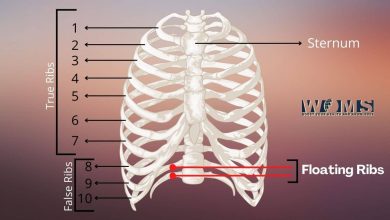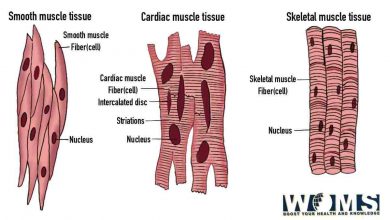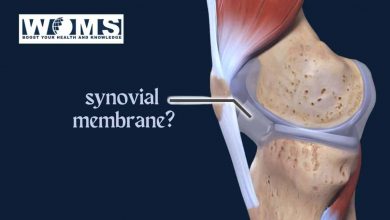Anterior Jugular Vein

An introduction to the anterior jugular vein, a vein that runs up the front of your neck and into your head. The anterior jugular vein is a part of the deep venous system.
It runs up the front of your neck, along the side of your windpipe, and into your head.
This article will show you where it’s located, what it does, how it works, and what you can do if there are problems with it.
What is the anterior jugular vein?
The anterior jugular vein is the blood vessel that carries blood from the brain to the heart. It lies in front of the carotid artery and behind the trachea, or windpipe. It also runs along the lower portion of the internal jugular vein. The main function of this vein is to return blood from the head and neck back to the heart for a fresh supply of oxygen-rich blood. It’s also important to read detail about the anterior triangle of the neck.
The anterior jugular veins are paired veins that connect to the subclavian veins. Blood flows from them into the right and left brachiocephalic veins and then into the superior vena cava on its way to the heart. Because of this connection, the anterior jugular vein lies behind the esophagus and trachea
What is the function of the anterior jugular vein?
The anterior jugular vein is a large vein that carries blood from the head and neck. It begins in the intermandibular fossa, located on either side of the mandible, and ends at the internal jugular vein. This vein delivers blood to the right and left brachiocephalic veins, leading to the superior vena cava. It also provides a pathway for air to move from the trachea back through the glottis and esophagus.
How can I locate my anterior jugular vein?
The anterior jugular vein is a large, pulsating vein located on the side of your neck, on the chest wall. Its position will depend on whether you are standing or lying down. While you are standing, it will run vertically up your neck; sitting or lying down will be horizontal.
If you are about to have a medical test, you need to know where your neck and head are located on your body. You can get some information about this by asking your doctor. He or she may even have a mirror that can be used while walking around the office. You can then hold the mirror up to your face and look at yourself in it while you talk to your doctor, which will help give him or her information about where you are concerning the location of your head and neck on your body.
How does it work with the carotid artery and reticular endothelial network?
Carotid arteries and reticular endothelial networks are two parts of the circulatory system. Carotid arteries carry oxygen-rich blood out of the heart to all other organs in the body, while reticular endothelial networks are the walls of blood vessels that make up the body’s circulatory system. The anterior jugular vein ends at the internal jugular vein, joining with several other veins to form a larger vessel, known as the subclavian vein. This vessel then drains blood into either the right or left brachiocephalic veins, leading to the superior vena cava and eventually to the right or left ventricle.
How does this vein work with muscles?
The anterior jugular vein is a large, pulsating vessel that lies on the side of your neck. It runs vertically up your neck and then along with your throat (when you’re lying down) before running horizontally beneath the esophagus. The veins are paired and connect to the subclavian veins, leading to the superior vena cava. This vein is surrounded by many muscles, such as the scalenus anterior, scalenus medius, and sternocleidomastoid.
Are there any conditions associated with this region of our body?
Yes, several conditions can occur in this area of your body. People often have no symptoms from these conditions, but you may notice some changes in the condition. Some of these conditions include: thrombosis, migraine headaches, and trauma
- Thrombosis: This condition occurs when a blood clot forms in an artery in this region of your body. The cause of thrombosis is generally unknown, and it occurs more commonly in women than men. Symptoms can include typical symptoms of heart disease such as chest pain, shortness of breath, and numbness on one side or both sides of the body.
- Migraine headaches: Migraine headaches are common, and they affect 50 percent of women during their lifetime and 25 percent of men during their lifetime. The cause of migraines is unknown, but they are generally thought to be linked to changes in hormones.
- Trauma: Trauma may occur when there is an injury in this part of the body, such as a stroke or internal bleeding that may cause bleeding into the brain. The signs of trauma include sudden loss of consciousness, confusion, and headache.
The suprasternal muscles are two large muscles on either side of the neck that form a V-shape over your sternum. The muscles can be used to pull the strap of a backpack over your head, but they are also used for breathing when a person inhales and then exhales or even support your head when you’re lying down. This is important because they also help support breathing.
Is the anterior jugular vein and internal jugular vein the same?
The internal jugular vein is a smaller, thinner vessel that runs vertically along the side of your neck. It connects with the subclavian vein at the bottom of your throat. The internal jugular vein is located in the same position as the anterior jugular vein; however, it is smaller and thinner. The internal jugular vein drains blood from your head back to your heart.
What are the common clinical conditions associated with this vein?
The anterior jugular vein can be affected by trauma, migraine headaches, or thrombosis, a blood clot formation in an artery. It is also susceptible to varicose veins or swollen veins that cause it to appear larger than normal. If a person has a large belly, the anterior jugular may become stretched out and appear larger.
The internal jugular veins are subject to dilated veins or varicose veins, which causes them to become larger than normal.
Where does the anterior jugular vein drain into?
The anterior jugular vein and the internal jugular veins are two different structures. The structure called the “anterior jugular vein” is a smaller, thinner vessel that runs vertically along the side of your neck. It connects with the subclavian vein at the bottom of your throat. The internal jugular veins are subject to dilated veins or varicose veins, which causes them to become larger than normal. If a person has a large belly, the anterior jugular may become stretched out and appear larger.
What causes this vein to become dilated?
Over time, the internal jugular veins may become dilated due to increased blood pressure or swelling during pregnancy. A person with varicose veins can also develop these extra varicose veins. This happens because new capillaries form in this part of the body when blood vessels are torn or dilated. If the blood flow through these new capillaries stops, then a person may experience other symptoms such as bleeding and swelling in this area of their body.
What is the most important vein in your neck?
The vein that is most important in your neck is the jugular vein. It runs from the carotid artery at the top of your throat and down to your heart. It is a major vein because it carries oxygen-rich blood to your heart. As blood circulates throughout the body, it is continuously being filtered by the liver and sent to your heart. The jugular vein has a drainage system that diverts blood into smaller veins that drain away from the head and neck region and back into the heart.
The jugular vein doesn’t just play an important role in our neck region; however, it also plays an important role in our cardiovascular system. It plays this role because its primary function is to carry deoxygenated blood back to the heart for recirculation. A person’s cardiac output and cerebral circulation depend entirely on unidirectional, low resistance flow of this kind.
What are the symptoms of a blocked artery in the neck?
The most common symptom of a blocked artery in the neck is when unconscious. A symptom that could indicate this problem is when a person loses consciousness and does not regain it for more than ten minutes. There may also be breathing difficulties sweating episodes, and the loss of consciousness, which would suggest this problem. Another sign is sudden abnormal changes in one’s mental status, such as confusion, combative behavior, or coma. All these symptoms may also occur alongside one another or happen individually.
How do I know if my JVP is high?
High blood pressure is a condition in which the force of blood against the walls of arteries is greater than the force of blood against the walls of veins. As a result, either pressure or volume can build up in either one of the structures. The jugular vein will appear larger than usual, and the neck veins may appear enlarged and bulging due to high blood pressure.
If you are experiencing such symptoms, you must visit your doctor for a checkup to ensure that your jugular vein is not swollen from blood clots or hemorrhaging. If you have unexplained daily headaches, vision problems, tingling or numbness in the face or hands, chest pain, and severe dizziness, you should also visit your doctor.
What causes trauma to this vein?
Trauma to this vein is caused by thrombosis or the formation of blood clots in an artery. If the arteries are blocked, then blood will not circulate, and it may flow backward into a vein. As a result, this vein could become damaged.
What is the effect of smoking on this vein?
Smoking can hurt this vein because it increases the risk of thrombosis or blood clot formation in an artery. This increases the risk of damaging this vein as well. Three out of four people suffer from recurring headaches every day. These headaches can often go undetected by patients, and they continue to live a life suffering from pain with no relief in sight.
How might a jugular vein spread infection?
The jugular vein may also be the site of infection because it has an open, unprotected blood flow vulnerable to bacteria and viruses. If bacteria or viruses enter the bloodstream, they can make their way to this vein and result in infection. This type of infection can sometimes be fatal. The common symptoms of this kind of infection are bleeding from gums, swollen neck veins, fever with shaking chills, or abnormal pain in the chest or joints.
Which side of the neck is the jugular vein on?
The jugular vein is on the right side of the neck, near it starts. It can be found by placing one’s fingers on Adam’s apple and feeling for a bulge under the skin. The jugular vein is also visible when one pushes their neck forward and presses down on their trachea with fingers. This bulge can be felt below a person’s nostrils, the tip of their chin, and the middle of the throat.
What are the symptoms of a swollen jugular vein?
In many cases, it can be difficult to determine whether or not a person has swollen veins in their neck because they may not even know that they have them until their doctor points them out through a physical examination. However, there are some symptoms that a person may experience if they do have swollen veins in their neck. These symptoms include pain or discomfort in the throat, an unusual or burning sensation in the throat, difficulty swallowing and speaking, swollen glands at the side of the neck, a sore throat that has lasted for one week, cough with yellowish-green sputum, fever, and chills often accompanied by shaking hands and feet.
Conclusion
The anterior jugular vein is the blood vessel that carries blood from the brain to the heart. These are paired veins that connect to the subclavian veins. Blood flows from them into the right and left brachiocephalic veins and then into the superior vena cava on its way to the heart. The main function of this vein is to return blood from the head and neck back to the heart for a fresh supply of oxygen-rich blood.
FAQs
What can cause pain in the jugular vein?
The jugular vein is a blood vessel of the vertebral canal. It starts from the subclavian artery and empties into the heart’s right atrium through the right atrial opening.
Does anterior jugular vein have a valve?
No, there is no valve in the anterior jugular vein. The only valve situated between the heart and the brain is the internal jugular vein valve.
Can jugular vein be compressed?
Yes, commonly the compression of jugular vein can be observed in the upper neck. Jugular vein compression can take place in conditions like craniocervical instability.
Is jugular vein palpable?
The jugular vein pulse is not as easily palpable as carotid pulse.




